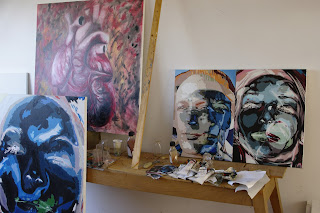“Personal
Responsibility” 2008:
In late 2007 I was invited to participate in the “M-tel awards
competition and exhibition of contemporary art in Bulgaria”,
the exhibition was to be from May 2008 to July 2008 in the city of Plovdiv Bulgaria. The
annual M-tel exhibition was consistently the largest and most important
contemporary art event in Bulgaria,
participation was by invitation only.
 |
| “Greedy”, 57.3’’-35.5’’, oil on canvas, 2008 |
Having received my invitation for the M-tel exhibition, I set about thinking about what to exhibit: previous work or something new. I had been working for two years on exhibiting work from “the process” and felt that it was time to move on, the M-tel exhibition presented itself as a good pretext and venue to offer something new to the public. Over the course of time from “the process” until 2008 I had become increasing interested in global issues, the problems that normal people were facing. In conjunction with my belief that art is about communication, I felt the need to talk about what I was seeing going on, and more importantly, how I personally felt about it. This lead to the juxtaposition of my own face with directly intelligible text illuminating the particular issues I wanted to talk about. The point was not to simply talk about what I felt, but to talk about what we all feel as these issues surround us. My hope was that by exposing my own feelings on these things I would inspire other people to do the same for themselves.
 |
| “I don’t want to see”,
35.5’’-57.3’’, oil on canvas, 2008 |
I created 5 large paintings for the exhibition. I chose to live stream
the creation of the paintings again as the third full installment of “the
process” with the hope that this would further expand the issues I wanted to
talk about in the minds of the people that would watch the project. The project
was watched by over 30,000 people over the course of two months. The public
reaction to the paintings was very good, the reaction of the organizers of the
exhibition was not: they were mainly concerned that the work was “too political”,
“too direct”.
 |
| “collective
guilt”, 35.5’’-57.3’’, oil on canvas, 2008 |
Original text for the
project:
The process 03 live streaming, Gordon Carter painting five new paintings. The present series of paintings are dedicated to several serious issues confronting the entire world as a unified society, though the emphasis here is on the personal responsibility of the individual in relation to the global problems. Gordon presents this from the select perspective of personal guilt and shame arising from a sensation of helplessness in the face of the magnitude of the issues and which is contributing to the individual’s inability to take real action to overcome these global problems. In the foundation of the concept of the these paintings is the idea that global change is not made by governments, but rather by the billions of individuals who have all taken personal responsibility for their own actions and then make a change; a change which, no matter how apparently microscopic, will indeed eventually be felt in the context of the global equation. The paintings take the issue of personal guilt as a starting point, that one may already realize the issues being presented, however despite this awareness and agreement over the issues, he still continues to remain inactive, carrying on with many daily activities that help to aggravate the problems; if these activities are directly influencing the dimension of the problems and the individual is aware of this and does nothing, then if he is in possession of a conscience, it can be expected that he would indeed feel some sense of guilt for his own contribution to these problems. The paintings also deal with the shame that one may also experience over these issues if he makes these connections, and the sensation that this is something so far beyond the individual; something that began long before him, and that will continue long after he is gone, leaving him with the feeling of knowing exactly what the problems are, and being totally helpless in his real desire to do something to overcome them. Gordon takes this as his foundation here, applying this to himself as a model for others to question themselves; but he does this also to suggest that even the act of talking about these things is indeed an action to help make things better. That even though this may seem insignificant and futile, this small action is actually going to impact in ways that cannot be foreseen. His idea is that the individual is in fact responsible for all the issues in the world; the world is like a massive algebraic equation, in which the changing of any variable in a positive or negative sense will in fact instantaneously change the entire equation positively or negatively despite the insignificance of that change. In this way, all are responsible, for every individual has the opportunity to change the entire world in a moment, though he may choose not to through the lack of faith in his own power.
 |
| “collective shame”,
35.5’’-57.3’’, oil on canvas, 2008 |
 |
| “Personal
Responsibility”, 53.3-74.8’’, oil on canvas, 2008 |























































